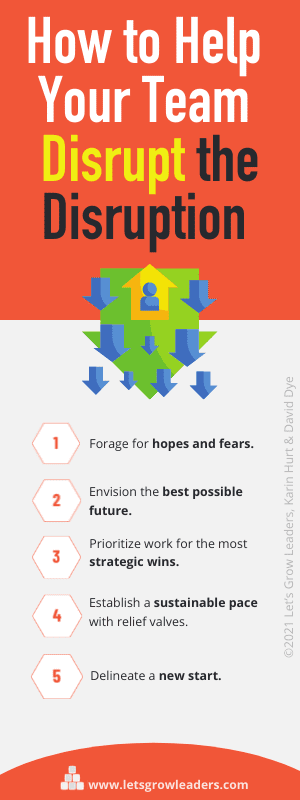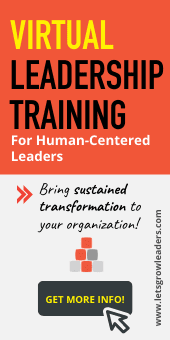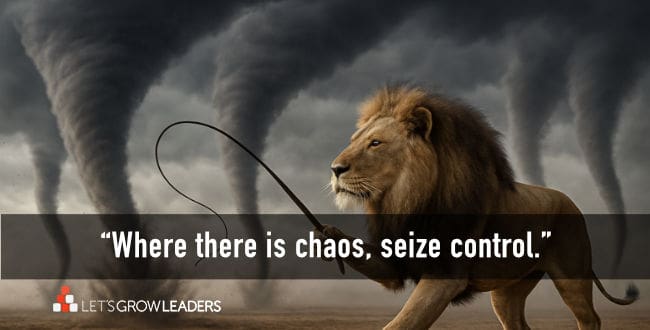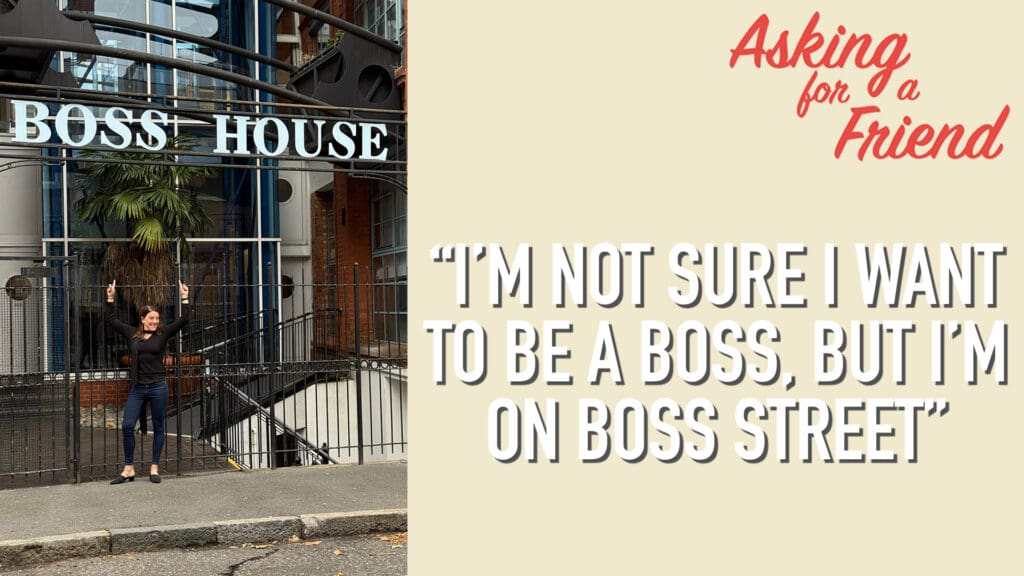How to Disrupt the Disruption
You wouldn’t have wished for this ridiculous, unprecedented disruption. But if you’re like many leaders I talk with, this stressful period has also been surprisingly energizing. Until it wasn’t.
You’re proud of your team. They’ve been working round the clock on a fast pivot. Maybe you’ve done more in the last sixty days than you could have ever imagined.
It’s weird, right? That positive adrenaline rush from the fast call-to-action in a crisis that is bigger than your biggest “that will never happen” contingency planning scenario.
I’m hearing about this phenomenon from so many of our clients—across a wide range of industries and circumstances.
And we’ve felt it too.
We’ve been on a fast scramble to move our in-person programs to live-online. We built out new curriculum and a multi-camera studio, with new stage views. And, we’ve added a bunch of new tools to keep our programs highly engaging. And it’s working. We have important work to do. Clients are happy.
There’s a huge sense of relief during a time when we are fortunate to have any work at all. The long days and weeks-that-ran-together scramble mattered.
Now the Slog
And, as I look at the new scene and think about how fortunate we are to have meaningful work and stay true to our mission, I also feel sad. I wonder, how long is this disruption our new normal? I miss some of you—because your programs were postponed or canceled. There are some programs that just won’t happen.
I miss passing the microphone around to hear your best thinking. Chatting with you about your experiences at book signings. The hugs after a long-term leadership development program. Oh yeah, and how in the world do we launch our new book in a pandemic? I think I even miss airplanes!
Are you feeling this way as you begin “the new normal?”
The urgent action has turned into a weary slog. Your people are tired. You’re tired. On top of that, you probably haven’t had a day off in a while, and summer plans are moving from “when we” to “if we.”
And there’s still so much unknown. You long to disrupt this unwelcome disruption.
The best description I’ve seen of what is happening in this next phase is in the HBR article, If You Feel Like You’re Regressing, You’re Not Alone.
In the beginning, when the emergency becomes clear, team energy rises, and performance goes up. Almost all of us have unknown reserves. As the executives’ experiences reflect, this reaction feels full of purpose and much gets done. Leaders tend to become the best version of themselves in this phase, and teams instinctively pull together and become highly productive. Few people question the leaders’ authority, and teams work in hectic, but harmonious, ways. The urgency created by the shock paves the way for rapid decision-making and turbocharges teams’ bias for action.
Then the second phase hits: a regression phase, where people get tired, lose their sense of purpose, start fighting about the small stuff, and forget to do basic things like eat or drink — or they eat and drink too much.
The concept of regression comes from developmental psychology and describes how people roll back to a less mature stage when faced with pressure. Regression is one of the mind’s ways to defend itself from confusion and insecurity by retreating to an emotional comfort zone.
The third phase is recovery—but we’re not quite there yet. Because we still don’t know what’s coming next. A new wave? A vaccine? Rebellion? Compliance? Unrest?
How to Help Your Team Disrupt the Disruption and Prepare for the Next Eighteen Months
We’ve been working with our clients (and focusing our own planning) asking one question to disrupt the disruption: What can we do to not just survive, but thrive in the next eighteen months?
It’s focused, short-term planning based on building the best next eighteen months possible assuming we’re going to be in a period of massive disruption for some time. This shift from “when will this be over?” thinking, is vital when leading your team into the recovery phase.
I don’t have all the answers, but I’ll share the kinds of conversations and planning we’re having with our clients right now.
1. Forage for hopes and fears.
We’re finding that teams are longing for cathartic conversation—to have a safe way to surface, and discuss hopes and fears that might otherwise go unspoken. We’ve been using our Let’s Grow Leaders learning lab technology to ask two important questions. “What are your biggest hopes for our team/organization in the next eighteen months?” and “What are your biggest fears during this same timeframe?” You can do the same with a quick anonymous pulse survey. The magic comes in the collaborative dialogue that follows.
Some of what scares people is poignant and surprising. By making the invisible hopes and fears visible, it’s easier to move to a productive “How can we?” conversation.
2. Envision the best possible future.
Our favorite definition of culture is Seth Godin’s, “people like us do things like this.”
Engage in conversation with your team about what you want “people like us” to do during this period of productive disruption. Get specific and granular about desired behaviors. Rethink processes. Do an Own the U.G.L.Y. exercise and figure out what’s got to go, to make room to help your team accomplish what matters most.
3. Prioritize work for the most strategic wins.
The world is changing so fast, what mattered most before might be less important now. With so many people working remotely in homes filled with emotional and physical distractions, it’s more important than ever to be crystal clear about what success looks like and what objectives matter most. Talk with your team about what’s vital, what’s changing, and why.
4. Establish a sustainable pace with relief valves.
We received a call from a Fortune 20 executive running an international team moving into the recovery phase, looking for support in helping their team make the next eighteen months as productive as possible. In one of our discovery conversations he shared:
As an international team, we’ve been dealing with this for a while now as we have a large presence in China. And we know this is far from over, and we’ve been moving at an incredible pace. We need to move from crisis to figuring out how we will work best in what’s going to be around for a while. I want them to feel a sense of relief and support during these sessions. We all need to feel safe to exhale.
5. Delineate a new start.
I loved this suggestion in the HBR article, to “disrupt the team and declare a new day one,” particularly the example of the executive who gave everyone new roles for this interim time.
She then introduced a new structure and assigned new roles for each of the team members. One member was assigned the role of being “CEO of acute, day-to-day crisis management.” Another member was asked to lead the planning and act as “CEO of the recovery phase.” And then quite unusually, she added a new temporary member — an up-and-coming talent — and charged him with driving long-term strategic changes faster.
It’s similar to the “Day 1” techniques used after an acquisition or merger. After all the discovery, due diligence, downsizing, and drama that often comes when two companies combine, it’s helpful to lay a stake in the ground of Day 1. From this moment forward something is different. We’re no longer slogging through, we’ve moved into our next phase of thriving.
Your turn.
What are your best practices for helping your theme thrive through these next eighteen months of disruption and challenge?
See Also: How to Change Your Mind and Not Lose Their Trust and Support








We took all our past awards off of the wall and put two words up, “what if…”
Mark, Oh wow! That certainly is inspiring. I’m so curious. What has the response to that been like?
As more and more people find themselves vaccinated, some offices are opening up, it will be interesting to see how the hybrid system is going to work. Will we need a smaller office with more meeting rooms, but fewer areas for working? Will we continue to hold space for people’s personal lives, managing children, and better recognition that people do have lives outside of work? I’m curious to learn what other people and companies will keep from the disruption!
Thanks, Michelle. I agree, this is going to be an important period of conversation, experimentation, and decisions. We have learned so much and there is still so much to learn as circumstances continue to evolve. We are having many such conversations with our clients now.
I agree. We have learned so much during these difficult times. Ironically, I learned that you could feel more connected to your team even when you don’t share a physical space. I believe this is because people realized that the only way to make it work was to acknowledge people’s personal lives and being flexible to accommodate different needs. That along is a great strategy to help your team thrive through disruption and challenge.